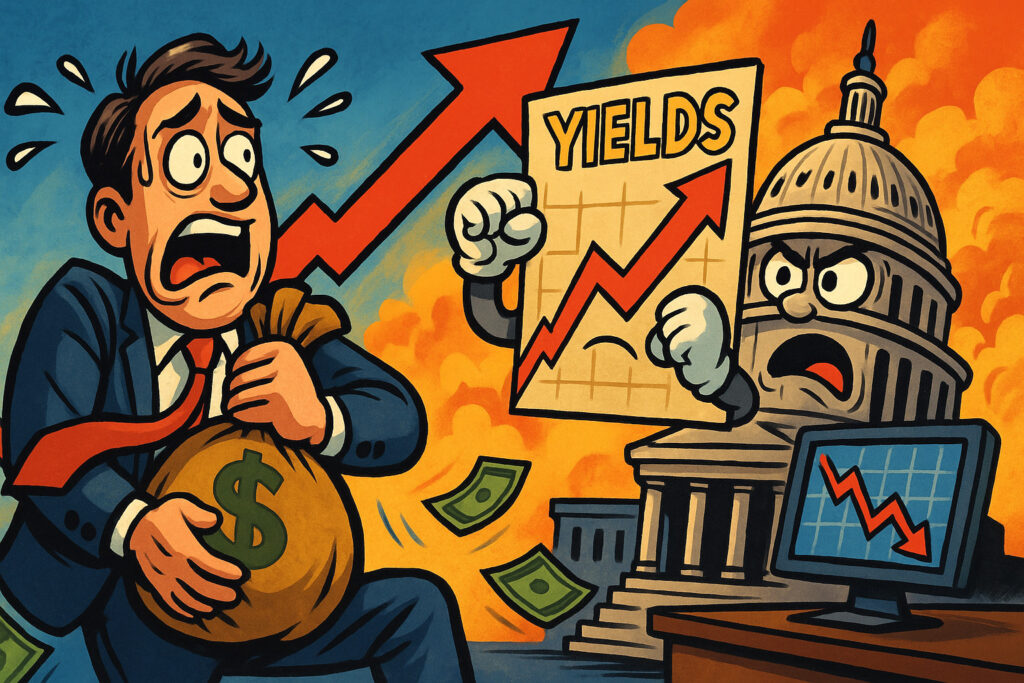Introduction
On May 20, 2025, the financial fallout from Moody’s downgrade of U.S. sovereign debt intensified, with Treasury yields spiking to multi-month highs and investors reassessing their exposure to American government bonds. While the initial market reaction was orderly, today’s moves revealed deeper apprehension about the long-term sustainability of U.S. fiscal policy.
The yield on the 10-year Treasury climbed another 12 basis points to close at 4.51%, while the 30-year yield jumped 14 basis points to 4.70%, the highest since October 2023. Risk sentiment remained fragile across asset classes, as market participants repriced duration risk, demanded higher premiums, and questioned the liquidity profile of U.S. government paper.
Market Mechanics: Treasury Selloff Accelerates
Following Moody’s Aa1 downgrade, institutional investors moved to the sidelines, reducing Treasury allocations in long-duration portfolios. Asset managers, insurance companies, and foreign sovereigns all appeared to adjust their positioning, triggering additional selling.
- 10-year yield: rose 12 bps to 4.51%
- 30-year yield: rose 14 bps to 4.70%
- 5-year yield: up 9 bps to 4.43%
The yield curve steepened further, reflecting heightened concerns about long-term fiscal management and inflationary risks.
Treasury Auction Weakness
A $38 billion auction of 10-year notes drew tepid demand:
- Bid-to-cover ratio: 2.11, the lowest since February 2021
- Indirect bidders: 56%, down from 62% last month
This weak demand suggests investor reluctance to absorb new supply at current pricing, particularly amid doubts about credit quality.
Asset Class Reactions
Equities: Defensive Posture
U.S. equities were mixed. Investors rotated further into defensive sectors while trimming exposure to financials and rate-sensitive names:
- S&P 500: -0.2% to 5,228
- Dow Jones Industrial Average: -0.1% to 38,144
- Nasdaq Composite: flat at 15,606
Top performing sectors included healthcare, utilities, and consumer staples:
- Pfizer (PFE): +1.5%
- NextEra Energy (NEE): +1.2%
- Walmart (WMT): +0.8%
Fixed Income Spread Widening
Spreads on corporate bonds and municipal securities widened:
- Investment-grade corporate spreads: +4 bps
- High-yield spreads: +8 bps
- Muni-Treasury ratios: rose to 82% (10-year), signaling relative value deterioration in tax-exempt debt
Credit Default Swaps
CDS pricing on U.S. Treasuries climbed another 6 bps to 51 bps, the highest since the March 2020 liquidity crisis.
Currency Markets: Dollar Rebounds, Then Retreats
The dollar index (DXY) rose briefly before paring gains:
- DXY: flat at 102.9
- USD/JPY: -0.2% to 146.4
- EUR/USD: +0.1% to 1.093
Forex markets displayed intraday volatility, reflecting uncertainty about the global flow of capital into dollar assets.
Commodities and Alternative Assets
Gold and Precious Metals
Gold remained a key beneficiary of risk aversion:
- Gold: +0.8% to $2,409/oz
- Silver: +1.1% to $29.30/oz
Oil Prices
Crude oil was largely unchanged, with geopolitical risks offsetting growth concerns:
- WTI crude: $96.25/barrel
- Brent crude: $99.80/barrel
Cryptocurrencies
Digital assets advanced as alternative stores of value:
- Bitcoin: +2.0% to $103,370
- Ethereum: +2.3% to $3,285
On-chain data suggested continued accumulation by institutional wallets, reinforcing Bitcoin’s evolving role as a macro hedge.
Global Impact and Reactions
Foreign markets were shaken by the U.S. yield spike:
- FTSE 100 (UK): -0.7%
- DAX (Germany): -0.6%
- Nikkei 225 (Japan): -0.5%
- MSCI EM Index: -0.9%
Emerging markets suffered outflows as rising U.S. yields reignited capital flight fears. Central banks in Brazil and Indonesia issued reassurances about FX stability.
Policy and Fiscal Response
Treasury Secretary Janet Yellen defended the resilience of U.S. capital markets but acknowledged that “fiscal trajectory risks must be addressed through bipartisan solutions.”
President Biden met with Congressional leaders to initiate discussions on a fiscal reform package. While both parties voiced concern, no consensus emerged.
Republicans emphasized entitlement reform and discretionary caps, while Democrats focused on tax reform and healthcare cost containment.
Analyst Commentary
- Wells Fargo: “The downgrade has jolted the long end of the curve. Until there is political will to tackle debt, yields will face upward pressure.”
- PIMCO: “Liquidity is intact, but spreads are flashing yellow. Investors should reduce interest rate risk and consider barbell strategies.”
- BlackRock: “This is a market recalibration, not a crisis. But the message to Washington is clear: credibility matters.”
Portfolio Strategy Implications
- Duration Management: Trim exposure to long-duration bonds; favor floating rate notes or short-dated Treasuries
- Sector Allocation: Increase weight in defensive and dividend-paying sectors
- Diversification: Maintain exposure to gold, digital assets, and inflation-protected securities (TIPS)
Conclusion
May 20 marked a significant escalation in the bond market’s response to mounting U.S. fiscal concerns. The Treasury yield surge, soft auction results, and defensive investor posture all underscore the importance of credible fiscal policy in maintaining market stability.
While liquidity remains robust and systemic risk is contained for now, investors are clearly reevaluating the long-term sustainability of U.S. debt. With global central banks watching closely and spreads beginning to widen, the road ahead could become increasingly sensitive to both macro data and political developments.
Until Washington presents a unified and credible fiscal roadmap, yields may remain elevated and investor sentiment cautious. For portfolio managers and policymakers alike, the post-downgrade world demands sharper discipline, deeper scrutiny, and a readiness to adapt to a shifting risk regime.
